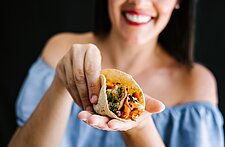This is Part 2 of a 2 Part Article - CLICK HERE to view Part 1
The Millennial Latino goes to Dinner
If there is a proving ground for authentic flavors and trends, we see it in dining habits. The Hispanic consumer carries tremendous clout in foodservice. In 2014, Hispanics spent $64.3 billion in restaurants. By 2019, this number is projected to double. There is no set type of restaurant where Hispanics like to eat – it is a highly fragmented area. As a group, Hispanics - especially millennials - are increasingly bicultural. They like to experiment and are open to a variety of restaurants.
In addition to a love of the authentic, Hispanic millennials are very brand loyal. When they latch onto a food or flavor, they are strong influencers – they will share it online. It is important to remember that children almost always factor into the Hispanic family’s dining experience. Today’s 20 year old Hispanic millennial was yesterday’s teenage family
member. The 900,000 plus Hispanic teenagers turning 18 this year profoundly affect where families eat and what they eat, and chains such as Chipotle and Qdoba strongly recognize this. As part of the bicultural dining experience, 66 percent of bicultural Hispanic families will have children joining them (including millennial family members). In fully acculturated families, the number drops to 44 percent again, once again showing the strong influence of younger family members on the dining experience in the bicultural family.
Drifting Away
The research that stands behind where Hispanics like to eat is somewhat uneven but worthy of examination. Not surprisingly, 89 percent of Hispanics say they eat fast food once a month, much as in a Gallup Poll from July, 2013, that showed that in general, eight out of 10 Americans eat fast food at least once a month. Interestingly, 83 percent of Hispanics report that they go to pizza restaurants once a month; 77 percent to Hispanic restaurants; and, 73 percent choose “casual chain dining” once a month. The data doesn’t drill down far enough. For example, do Hispanics consider Chipotle, Chinese take-out or consuming food truck food as fast food choices? It’s not clear but it seems apparent that the group is open to new and varied experiences.
Symrise Sabor in America Event Recap
Statistics that demonstrate that dining is a reflection of income are more reliable. Our research has shown that as income rises in the household, Hispanics become more experimental in their food choices at an almost direct proportion. In families where the yearly income is below $25,000, only about 37 percent are likely to experiment with different cuisines. However, when a median income reaches $50,000 to $75,000, experimentation with different flavors and different cuisines jumps to 47 percent.
As income levels rise, Hispanics and especially Hispanic millennials with higher education and income seem to drift away from the preference to dine in Hispanic restaurants. In households where the median income falls below $25,000, it is projected that 43 percent want to eat Hispanic food when they dine out. When their income rises to $50,000 to $75,000 there is a drop to 31 percent. From another perspective, a Hispanic millennial earning $60,000 a year is about two thirds more likely to eat foods other than purely Hispanic cuisine but is likely to continue to desire intense, authentic flavors. This is key for food development and marketing people.
The Hispanic millennial may be just as likely, or even prefer, a positive Asian dining experience with freshly made ingredients, intense herbs, spice flavors and authenticity over tasteless, packaged Hispanic foods lacking flavor and genuineness.
There seems to be a profound and lasting insistence on the part of Hispanic millennials for real flavors, intense flavors and real ingredients to match. It poses a tremendous opportunity to food developers who seize on this exciting vision for the future; however, it may yield disappointment to marketers who fail to see what this demographic requires.
image via arizonalatinos.com






